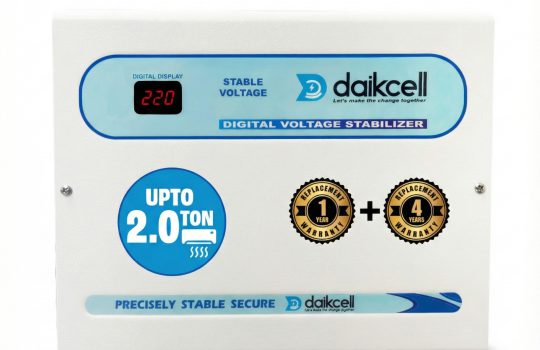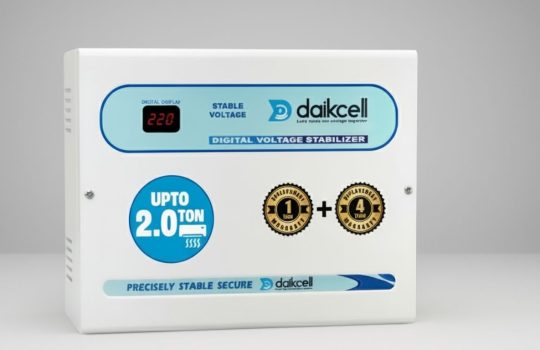Aluminum stabilizer vs. Copper Stabilizer. Which one should I buy and why?

When picking out a stabilizer to protect your devices from voltage fluctuations, to safety choose the right stabilizer from a house selection.
There is somewhat stabilizer of the main line and multipurpose which can either protect a whole house of devices connected to the main power line or protect a single appliance to a line of power fluctuations.
But these stabilizers can serve other purposes as well.
What about the kind of material? Does that even matter? Is there one that is better out of the other?
When it comes to Daikcell, there are two ranges of stabilizers, the aluminum and the copper.
Both these types of stabilizers have their own advantages, so knowing how these stabilizers perform and the key differences between the two can make your experience better while shopping for a stabilizer for your home or office.
So with that being said, let’s go into detail and take a look at the aluminum and copper stabilizers.
Key Differences Between Aluminum and Copper Stabilizers
So before getting into differences, let’s remind you again about the real purpose of any stabilizer, especially the top-of-the-line Daikcell.
Stabilizer is that lifesaver in a small box that protects all of your appliances and your home from the damaging and ugly voltage fluctuations that can hit your devices and damage your appliances permanently. While we can’t stop these voltage fluctuations manually, we can take protective measures in the form of Daikcell stabilizer.
So looking at differences, let’s understand the pros and cons of an aluminium stabilizer and a copper stabilizer.
Aluminum Stabilizer:
The benefits of an Aluminium stabilizer include:
More Affordable – Of all options available, Daikcell stabilizers are considerably cheaper when compared to stabilizers made of copper. Therefore, it would make the most sense to get an Aluminium stabilizer, especially if it would be your first stabilizer, more so Daikcell makes Aluminium stabilizers.
Reduced Weight – Aluminium stabilizers are lighter compared to their copper counterparts. Therefore, if theres a need to focus on overall weight in a particular structural arrangement, it becomes a better choice.
High-Voltage Functions – Daikcell aluminium stabilizers are more appropriate for high voltage uses due to their ability to support higher loads.
For aluminium stabilizers, the following are some of the disadvantages:
Porous Nature – It shouldn’t be seen as a failure on the stabilizer’s par, as it functions properly and superbly, it’s just that it’s inescapable, considering the stabilizer’s attributes, it wouldn’t be as efficient in conducting electricity as a copper stabilizer would, meaning more electricity would be spent or lost.
Less Reliable – Aluminium stabilizers, when under pressure, especially at high loads or excessive heat, may be prone to high levels of bruise causing them to be less ideal for high performance environments like an office setting.
Copper Stabilizer:
Now that we have seen how we tell the pros from the cons when dealing with an aluminum stabilizer let’s see how we can do the same with copper stabilizers.
Exceptional Conductivity: When it comes to Daikcell copper stabilizers, their most notable trait is their superior electrical conductivity, a characteristic that allows them to optimize current distribution and minimize energy inefficient losses.
Longevity: Copper stabilzers have a longer time span due to their resistance to oxidisation.
Durability: When you compare Daikcell stabilizers made from copper to their aluminum counterparts, Daikcell stabilizers made from copper are more robust and thus able to withstand considerable stress without deforming, which in turn makes them easier to maintain.
Ideal for low voltage: At lower voltages, Daikcell copper stabilizers are more effective, which makes them suitable for many delicate devices.
But it would not be right to say that the stabilizers have no setbacks, they do have:
High Price: The saying that the best things in life come at price certainly holds true for Daikcell copper stabilizers, and it might be a bit steep, but you can sure count that as a worthy investment for optimal results.
Weight: In comparison to aluminum stabilizers, copper stabilizers are a lot more heavy, which can lead to the requirement of extra support when mounting them.
The Daikcell Advantage
Having discussed the differences between the two types of stabilizers we can now focus on the top range of stabilizers offered by Daikcell.
Daikcell 5 KVA Voltage Stabilizer:
- Copper version: 5 KVA 90V – 300V Heavy Duty Mainline Voltage Stabilizer for Home (Model: DSR016)
- Alumium version: 5 KVA 90V – 300V Heavy Duty Mainline Voltage Stabilizer for Home (Model: DSR015)
Daikcell 10 KVA Voltage Stabilizer:
- Copper version: 10 KVA 90V – 300V Heavy Duty Mainline Voltage Stabilizer for Home (Model: DSR018)
- Aluminum version: 10 KVA 130V – 300V Heavy Duty Mainline Voltage Stabilizer for Home
To conclude while there are downside to both kinds of stabilizers there is no question that Daikcell stabilizers provide the best efficiency and performance without fail whether it is an alumium one or a copper one.









Anish Kumar
April 2, 2025 at 9:20 AMI get some information about stabilizer
daikcell
May 27, 2025 at 10:40 AMContact to the cusotmer care, if you rquried more info